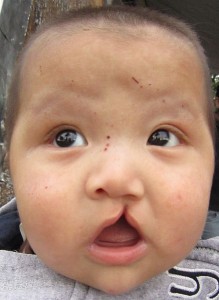 What is clefting? Cleft lip and cleft palate, called orofacial clefts, are facial birth defects that occur in the early weeks of pregnancy. The lip forms in three parts and the palate (roof of the mouth) in two sections; orofacial clefts occur when the sections of the lip and/or palate do not join completely before birth. The reason for most clefts is unknown, and therefore cannot be prevented. There may be a genetic component, as the clefts tend to be more common among certain ethnic groups. Cleft lips and cleft palates are among the most common birth defects in the United States.
What is clefting? Cleft lip and cleft palate, called orofacial clefts, are facial birth defects that occur in the early weeks of pregnancy. The lip forms in three parts and the palate (roof of the mouth) in two sections; orofacial clefts occur when the sections of the lip and/or palate do not join completely before birth. The reason for most clefts is unknown, and therefore cannot be prevented. There may be a genetic component, as the clefts tend to be more common among certain ethnic groups. Cleft lips and cleft palates are among the most common birth defects in the United States.
How are clefts diagnosed? Most of the time, clefting causes very obvious physical changes and can often be detected on a prenatal ultrasound. If the condition was not detected prior to birth, it is generally found in the newborn physical examination. Often times, additional testing will be conducted to check for genetic abnormalities.
What problems are associated with orofacial clefts? A separation in the lip and/ or palate can cause a variety of problems, including eating problems. When the cleft palate exists, liquids may pass from the mouth and back to the nose. Some children with cleft palates must wear man-made palates when they eat, to maintain adequate nutrition until they get proper surgical treatment.
Some children will have difficulties with speech. The orofacial clefts may make it difficult for their voices to carry, or they may sound nasal or be difficult to understand. For children whose speech is affected, speech pathologists can help resolve the difficulties.
Children with clefting are more prone to hearing problems and ear infections, because they are more susceptible to fluid buildup in the inner ear. Consequently, many children will have tubes placed in their ears to assist with drainage and will have their hearing checked annually.
Dental issues are also more common among children who have cleft lips or palates. Many will require significant dental and orthodontic care. Some dental problems may need to be corrected though oral surgery.
How are cleft lips and palates treated? Orofacial clefts are most effectively treated by a team of professionals, including surgeons, dentists, orthodontists, and speech therapists. Cleft lips generally require one or two surgeries, with the first often being completed before the child is three months old. Cleft palates may require a number of surgeries over the course of several years.
The first surgery generally occurs when the child is 6-12 months old and creates a functional palate, aids in the development of teeth and facial bones, and decreases the risk of extra fluid in the middle ears. Subsequent surgeries may include bone grafts to fill in the upper jaw, improve the appearance of the nose and lip, and repair scars left from the initial surgeries.
Physicians skilled in cleft repairs are available in many areas of the United states. International charitable organizations partner with volunteer surgeons and nurses to perform the cleft repair surgeries in areas of the world where the appropriate care is not affordable or readily available. Although proper treatment may extend over several years, most children who are born with clefting are able to achieve normal eating, appearance, and speech.
